In Italy the largest-ever exhibition of Edward Burtynsky, the photographer of climate change
Museum M9 - Museo del ’900 in Mestre is hosting a major exhibition by Canadian photographer Edward Burtynsky (St. Catharines, 1955), entitled BURTYNSKY: Extraction / Abstraction, from June 21, 2024 to January 12, 2025. The exhibition aims to give the public an overview of Burtynsky’s long career, exploring the theme of large-scale industrial incursions and the impact ofhuman activity on ecosystems. Curated by Marc Mayer, former director of the National Gallery of Canada and the Musée d’Art Contemporain in Montreal, with an installation design by Alvisi Kirimoto, this is the largest exhibition ever mounted on Burtynsky’s work. Following the success of its presentation at the Saatchi Gallery in London, the exhibition comes to Italy for the first time.
BURTYNSKY: Extraction / Abstraction focuses on landscape and climate change, exploring the interactions between humans and the environment and investigating the environmental consequences of the industrial system, a central theme in Burtynsky’s production. The artist, known in Italy for his 2019 Anthropocene project, invites viewers to reflect on the impact of humans on Earth’s habitats, going beyond the surface of his images to understand the future of ecosystems. The exhibition is divided into six thematic sections illustrating Burtynsky’s main fields of action, with more than 80 large-format photographs, 10 ultra-high-definition murals and some innovative photographic tools, including drones. In addition, the exhibition integrates elements that dialogue with the museum’s narrative on the transformations of the 20th century.
On the museum’s second floor, nine photographs from the photographic campaign commissioned by the Sylva Foundation in 2022 document the effects of Xylella on Apulian olive trees, an environmental disaster that highlights the effects of climate change in Italy as well.
The new M9 Horizons room will also screen the short film In the Wake of Progress (2022), co-produced by Burtynsky and renowned music producer Bob Ezrin, with original music by Phil Strong. The short film will be presented in immersive mode and for the first time in Italy. The exhibition will be accompanied by a program of talks and screenings on the themes of the Anthropocene, energy transition and environmental sustainability, to be held in the “Cesare De Michelis Auditorium.”
The exhibition is sponsored by the Veneto Region, the City of Venice, the Embassy of Canada, Ca’ Foscari University Venice and the CMCC Foundation - Euro-Mediterranean Center on Climate Change. It is supported by Official Partners such as the Chamber of Commerce of Venice and Rovigo, BRT and Trenitalia. The realization of the exhibition sees the collaboration of Sylva Foundation, Intesa Sanpaolo, Confindustria Veneto Est, Vela / Venezia Unica, Save Group and other partners. Media partners for the event are Rai Cultura, Rai Radio 3 and Domus, with Communication Partner Multistudio of Treviso.
Opening hours: in the June-August period from Wednesday to Friday 10 a.m.-6 p.m. and Saturday and Sunday 10 a.m.-7 p.m. During September-January from Tuesday to Friday 10 a.m.-6 p.m. and Saturday and Sunday 10 a.m.-7 p.m. Tickets: €10 full, €8 reduced (for minors from 7 to 18 years; students up to 26 years with Student Card or student card/university booklet; residents of the municipalities of Venice, Mira, Spinea, Martellago, Scorzè, Mogliano Veneto, Marcon, Quarto d’Altino and Mirano; visitors older than 65 years; beneficiaries of existing conventions), €8 reduced groups (rate per person; min. 10, max 30 people);, €5 reduced University students on Thursday, €20 reduced Family (2 adults and one minor from 7 to 18 years; + €2 for each additional minor). Permanent exhibition + Burtynsky exhibition admission costs €15 full, €12 reduced. Free for M9 Card holders; ICOM members; minors up to 6 years old; persons with disabilities; 1 chaperone per group; 1 chaperone per person with disabilities; tour guides with badges. Thursday free admission from 3 p.m. until the close of the ticket office for residents of the Metropolitan City of Venice. This type of ticket is issued exclusively at the ticket office.
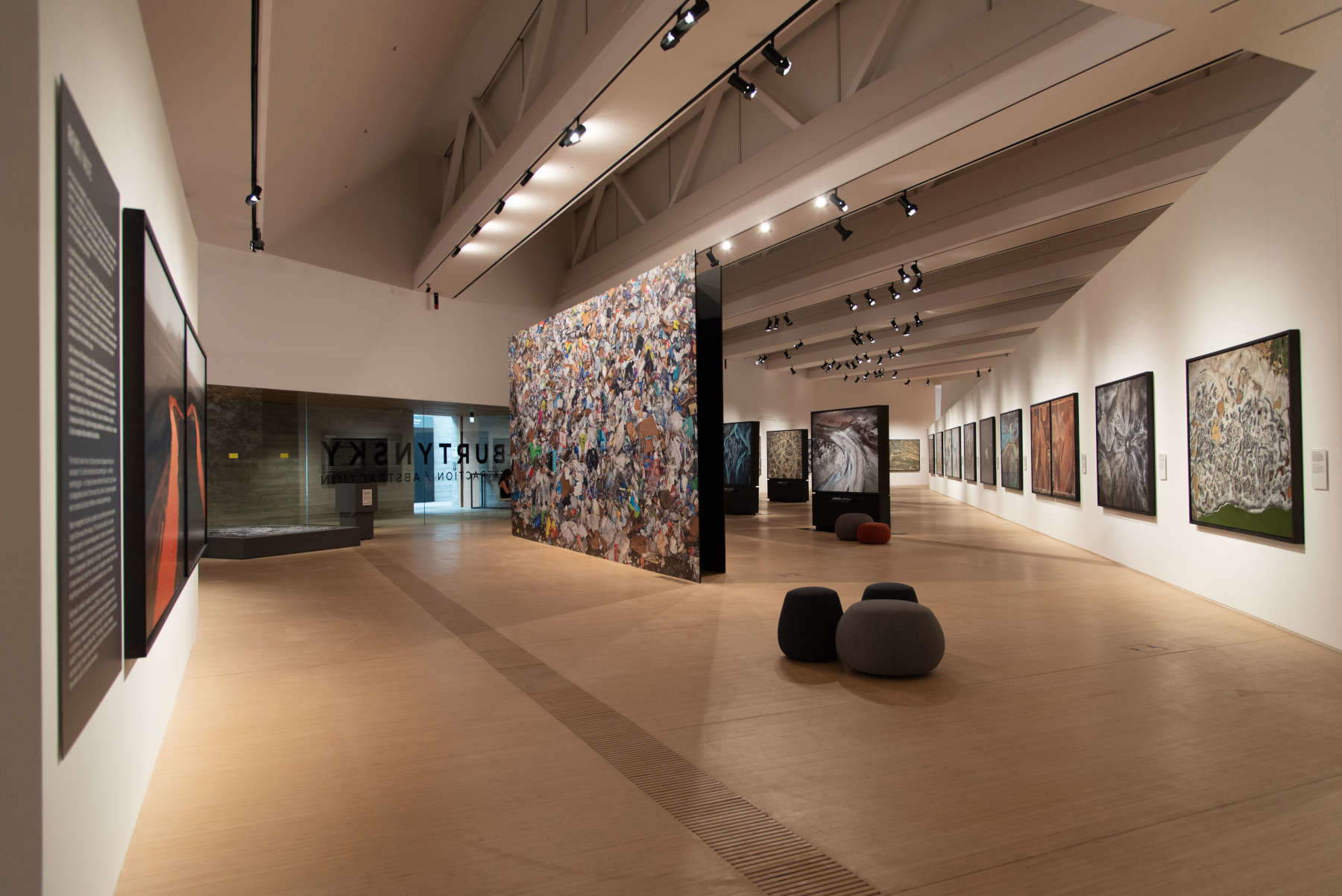
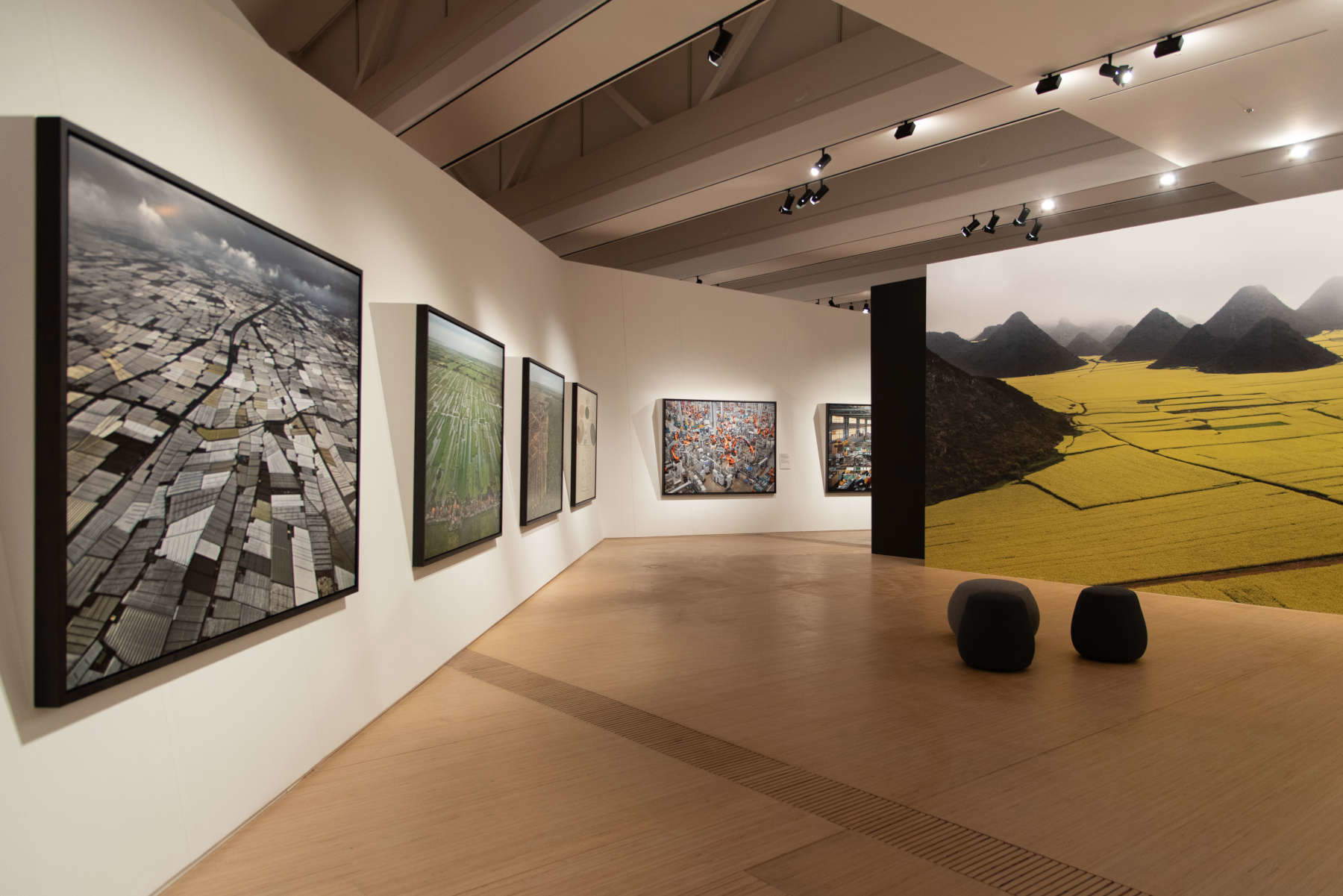
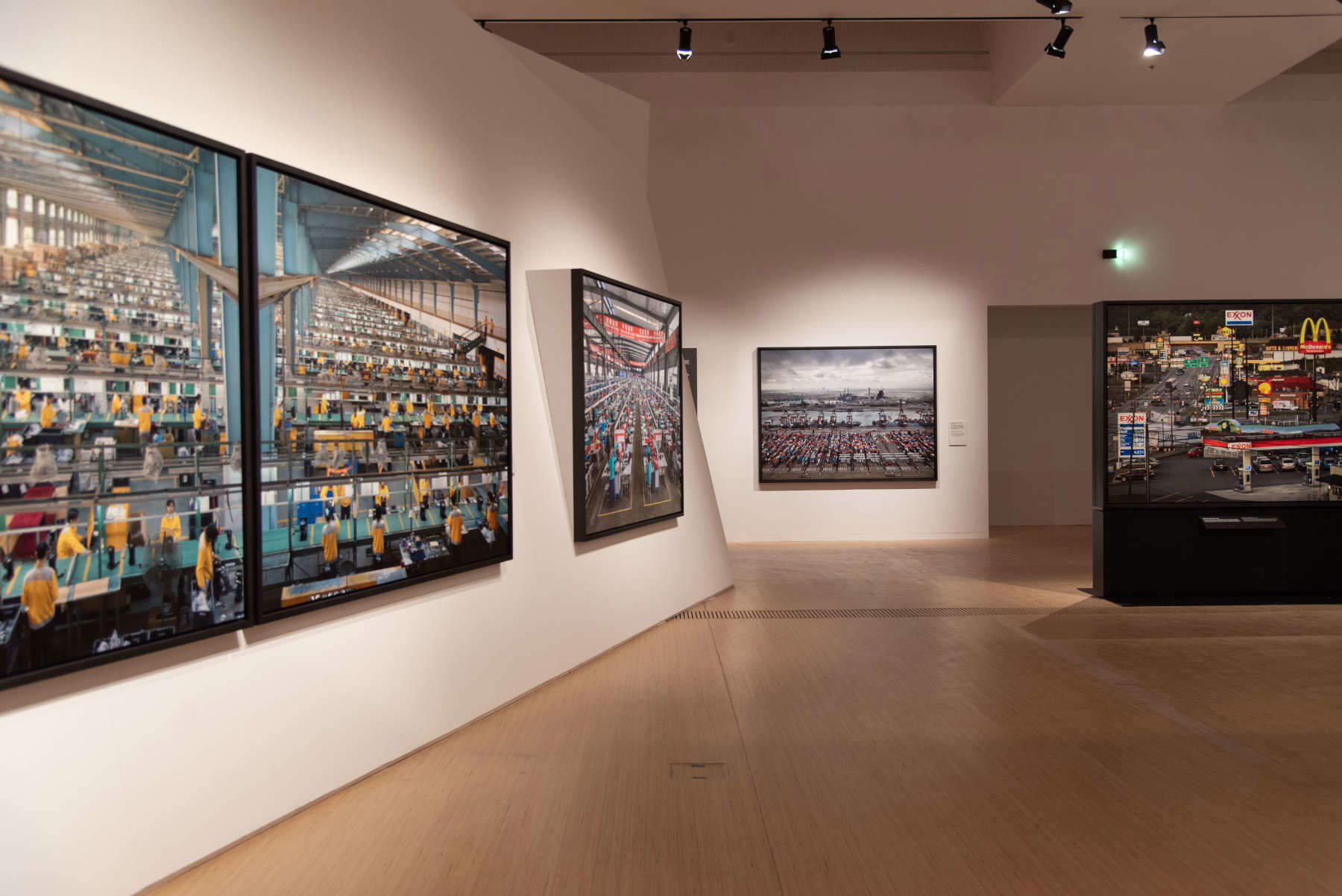
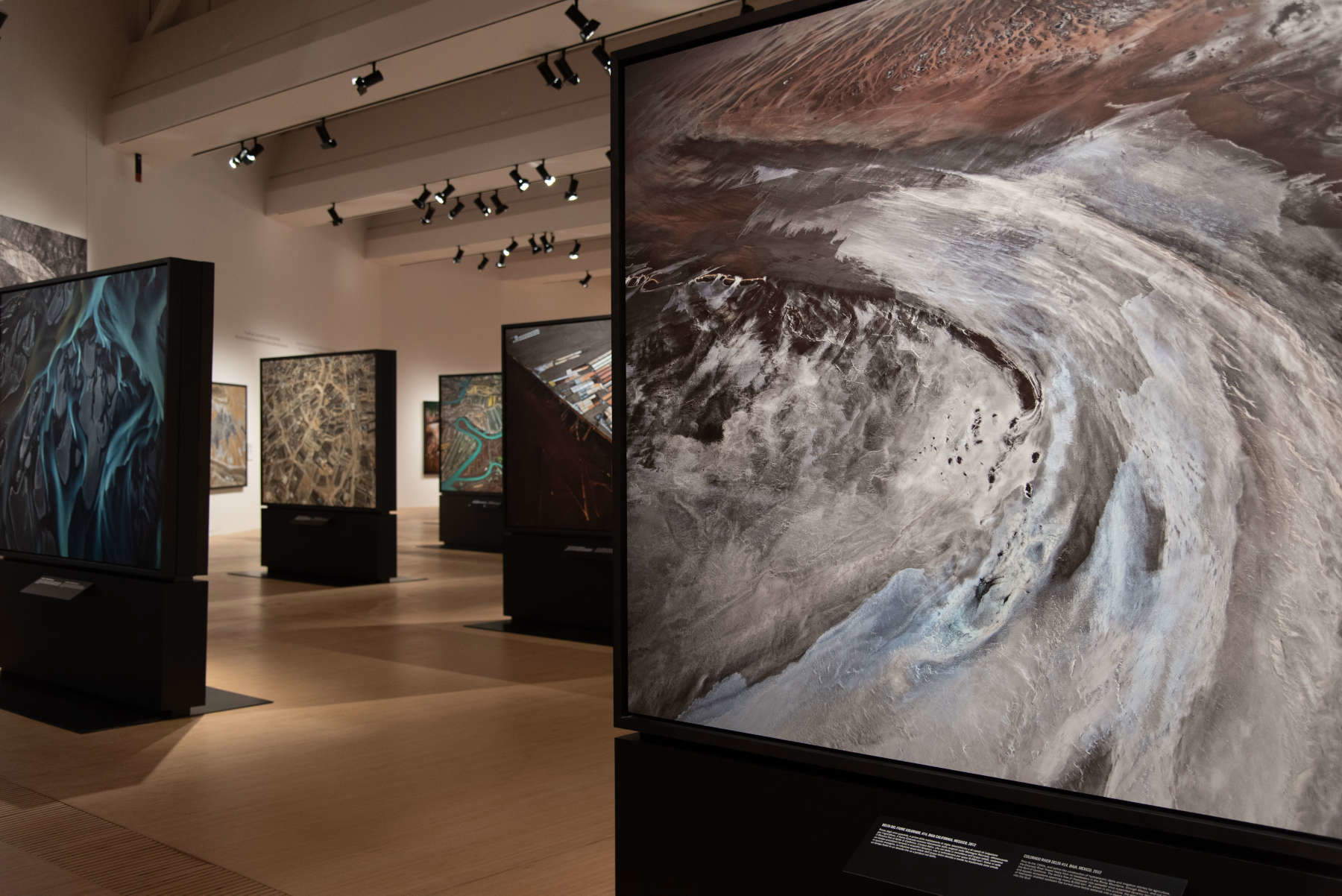
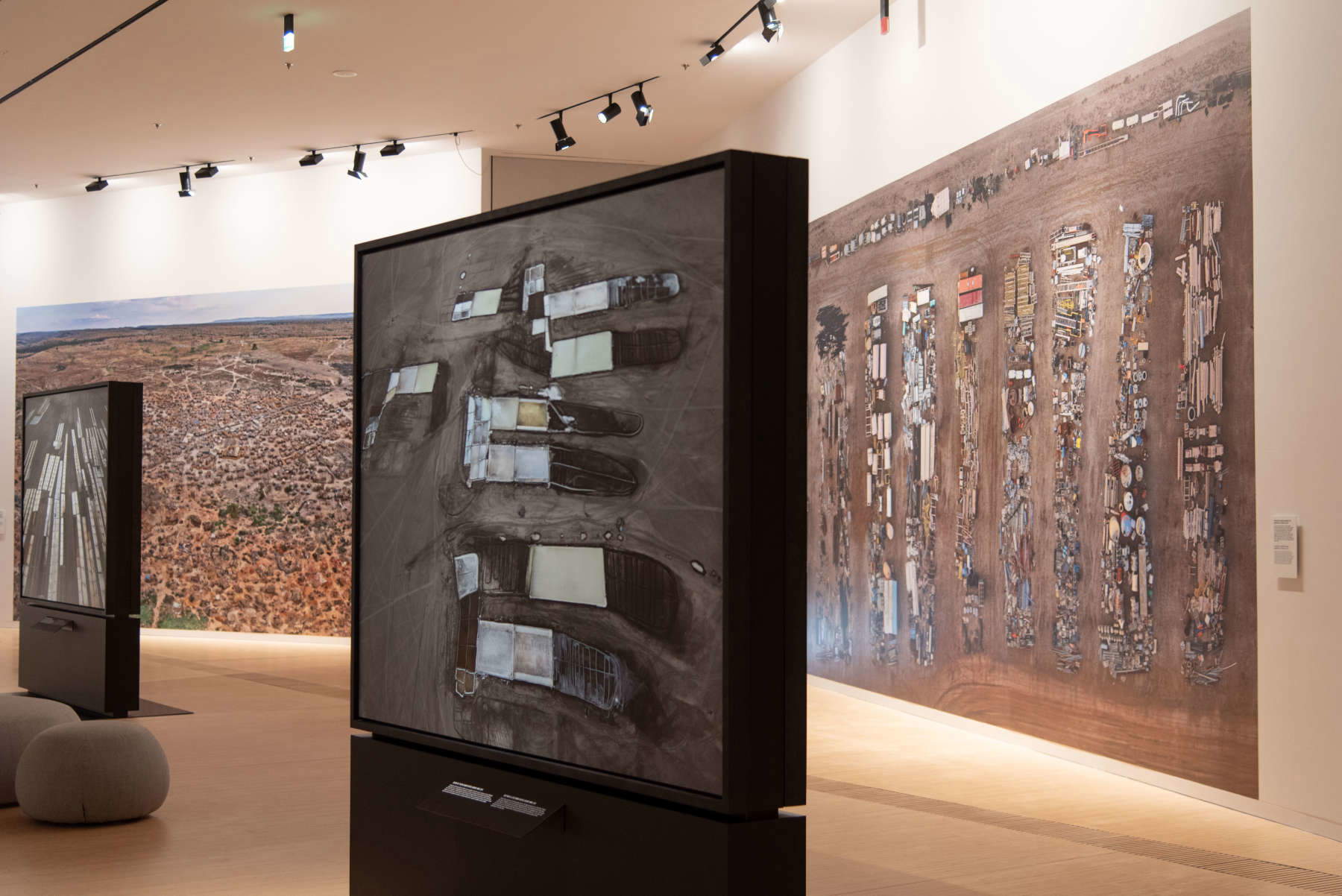
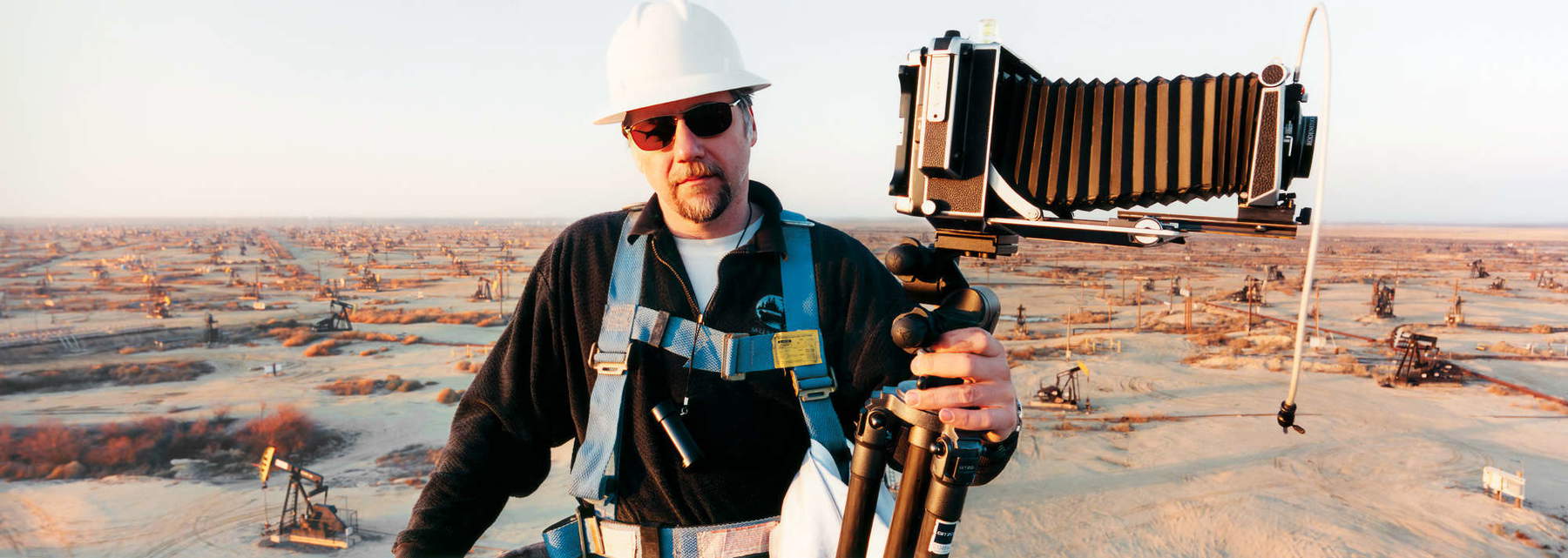
The exhibition design
Alvisi Kirimoto signs the installation design for the exhibition BURTYNSKY: Extraction/Abstraction and traces the photographer’s work in line with Marc Mayer’s curatorial vision, articulating the exhibition path in the different spaces of the museum and mainly in the third-floor room dedicated to temporary exhibitions. It is precisely in this room that the exhibition is developed around the "Splinter," a freestanding structure placed in the center of the main room, created by the studio for a previous exhibition. Consisting of three irregularly shaped folded sheets, the Splinter stands out as a decisive element that punctuates the space and shapes the identity of the exhibition, allowing optimal enjoyment of the works on display. The images presented include powerful framed photographs, large-scale murals and an augmented reality experience, offering an intense visual narrative of the impact of human action on the planet.
The pathway unfolds on two fronts: the existing walls of the museum and the Splinter from different layouts, and the new exhibition surfaces that punctuate the space orthogonally. These include the Mural Walls and Totems, bifacial elements positioned parallel to each other that house the works and, with rigor, give rhythm to the space.
On the second floor, the new M9 Horizons room houses the immersive installation In the Wake of Progress (“In the Wake of Progress”), while the second floor space is designed as an introductory environment that offers a first glimpse into Burtynsky’s career. Here, a large banner enhances the museum’s triple height with the work Shipyard #11, Qili Port, Zhejiang Province, China, 2005. Also on the second floor, the Xylella Studies series of photographs is on display, documenting the bacterial disaster on olive trees in Puglia.
The third floor, a room of more than 1,200 square meters, is entirely dedicated to the exhibition, and divided by the Splinter into three main sections: Abstraction (“Abstraction”), which explores the artist’s techniques and the resemblance of his photographs to abstract art; Extraction (“Extraction”), Manufacturing and Infrastructure (“Manufacturing and Infrastructure”), Agriculture (“Agriculture”) and Waste (“Waste”), i.e., the five central themes investigated by Burtynsky; and finally Archive of Process (“Archive of Processes”), which examines the artist’s working methods, his technical evolution, and tells the photographer’s professional history, showing the tools used during his career.
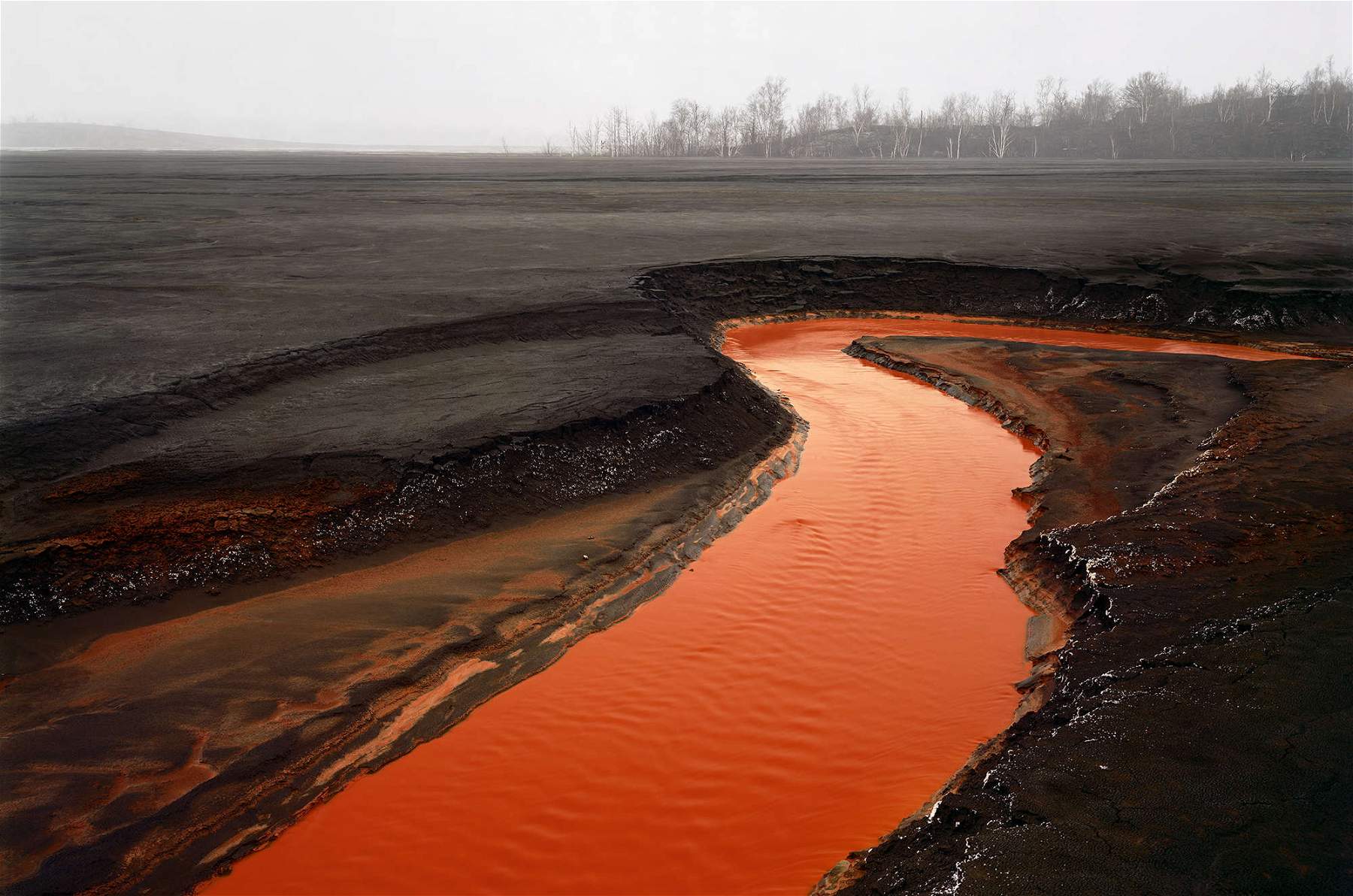
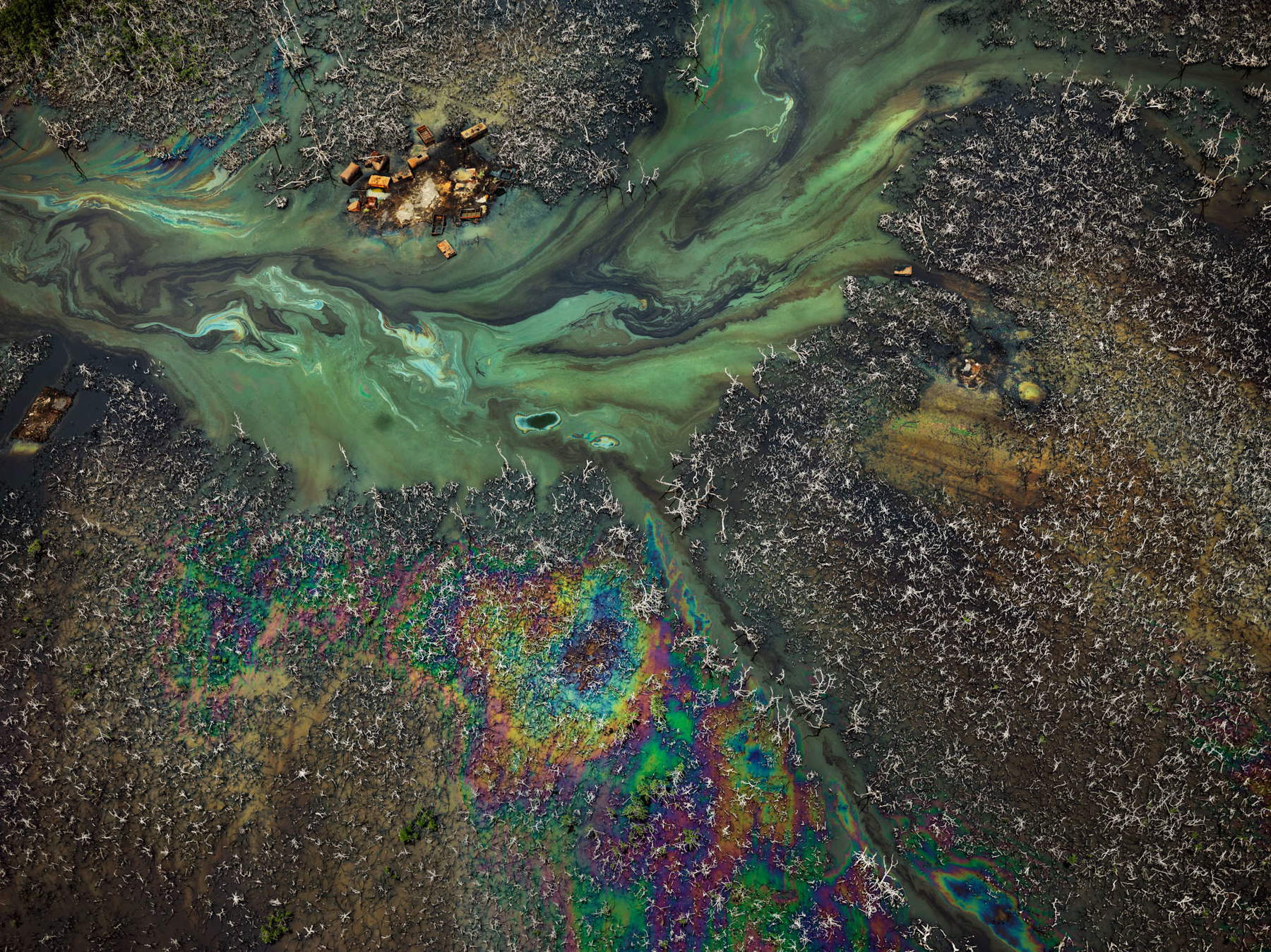
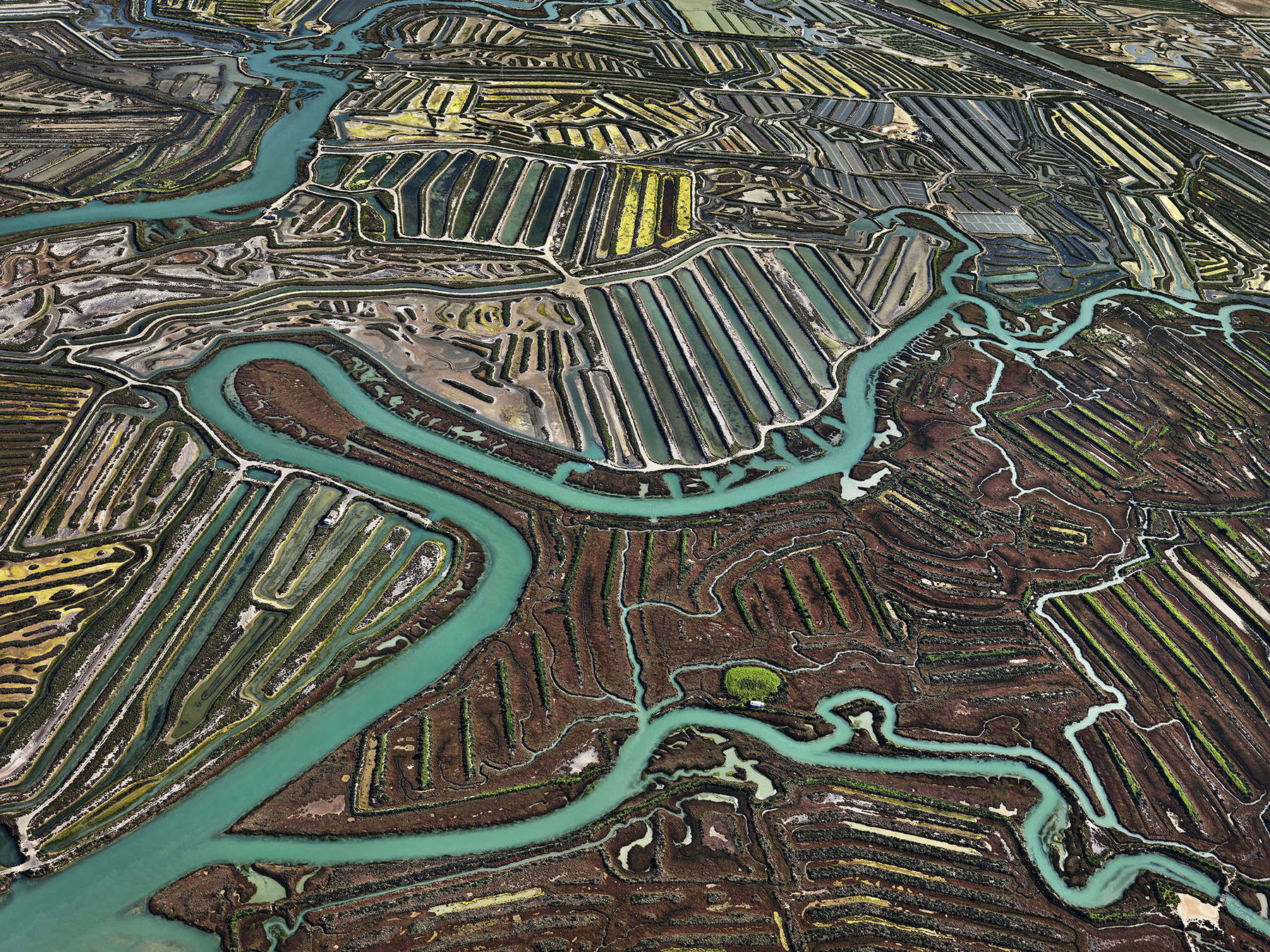
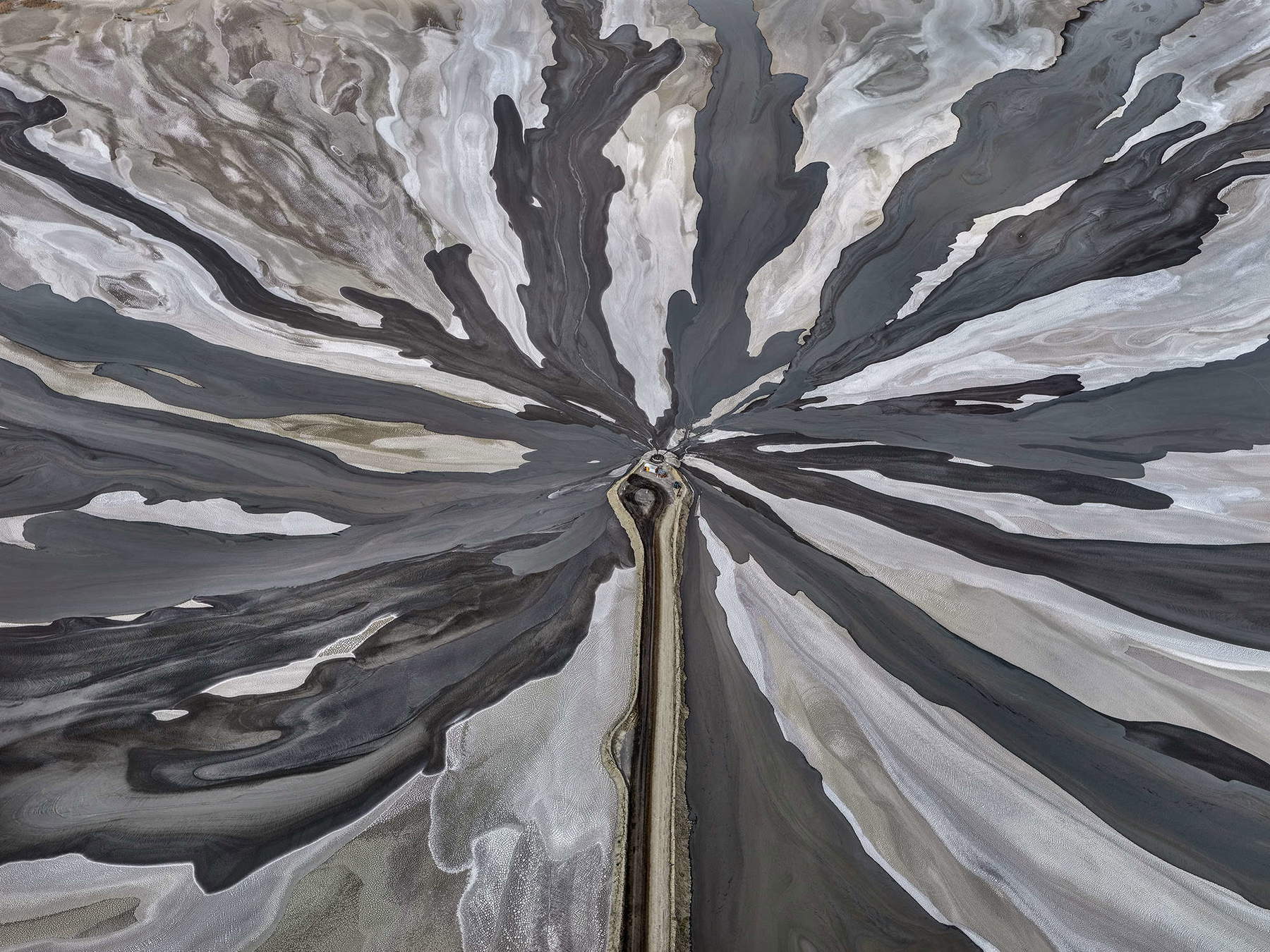
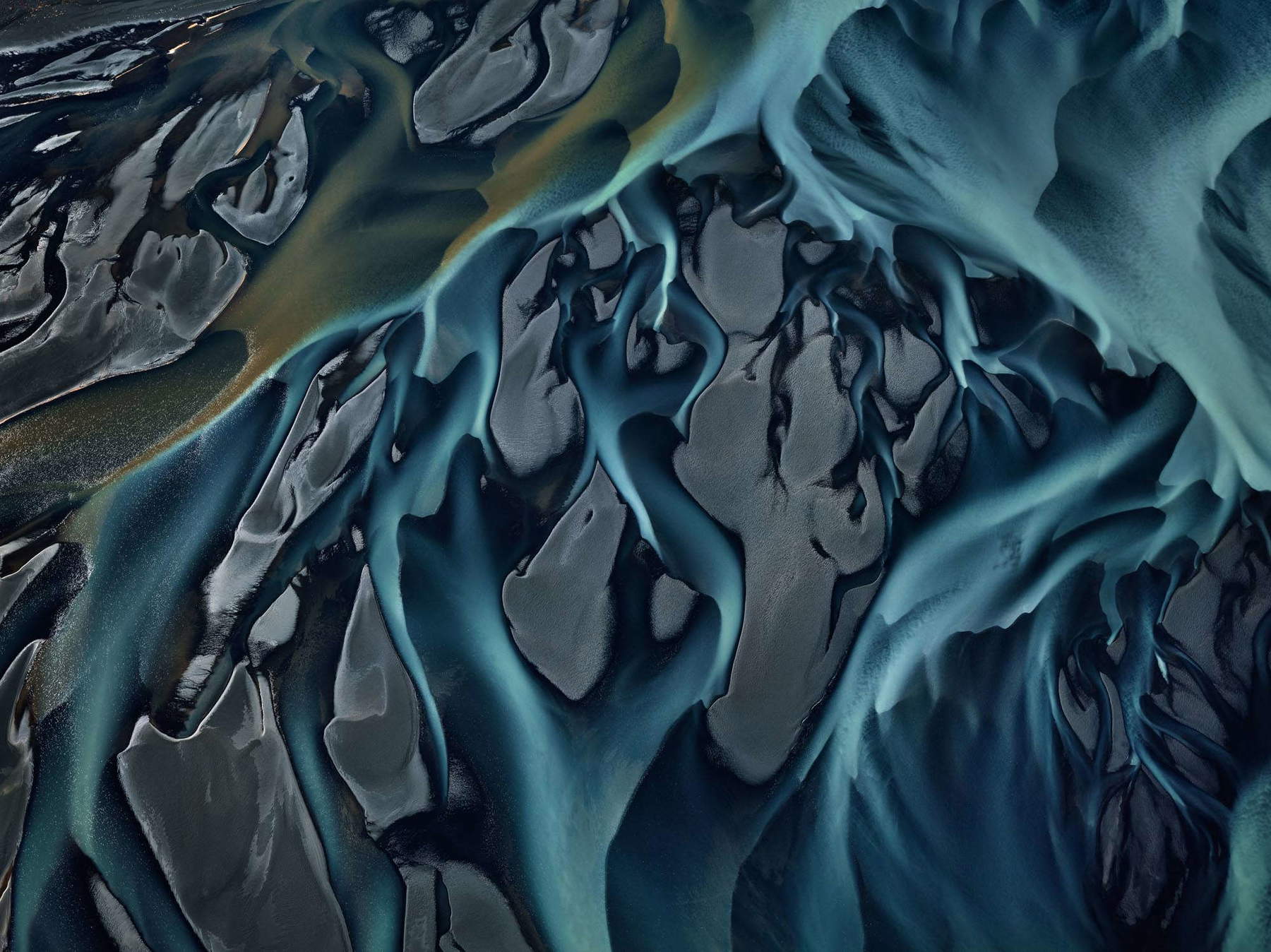
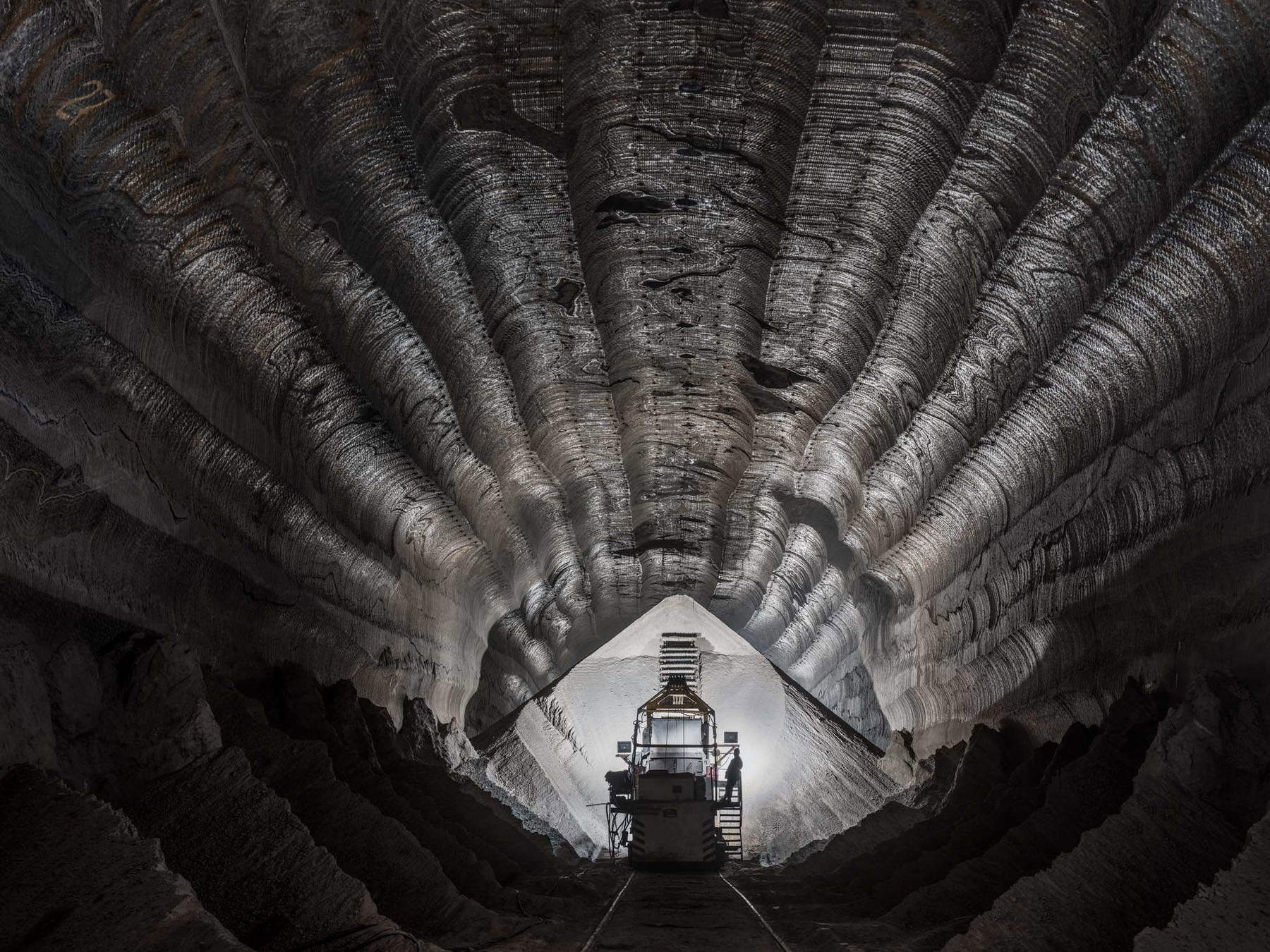
The exhibition’s itinerary
The exhibition takes its name from a coincidence of synonyms. “Mining” refers to mining, one of the most important subjects for Edward Burtynsky. “Abstraction” is a synonym for mining and also refers back to abstractionism, Burtynsky’s typical pictorial approach.
The first section, Abstraction, starts with abstract art, which arose in the early 20th century as a radical break with old artistic methods. Instead of representing recognizable figures, objects or landscapes it explores form, structure and color as such. The same period saw the birth of the agricultural industry, mass production, surface mining and the internal combustion engine, which changed our way of life. While modern artists were inventing new emotional languages, industrialists were constructing a new reality, alien to the natural world and anything but sustainable. Edward Burtynsky’s photographs capture us with frequent allusions to the conventions of abstractionism. We happen to appreciate their abstract beauty before recognizing the sites of drudgery and, too often, human folly.
Next comes Extraction: reflecting on how the burgeoning mining industry unearths the materials on which our modern way of life is based. But digging tunnels deep into the earth’s crust is just one of the ways used to extract valuable raw materials. Miners exploiting open pit mines blast buried treasures with explosives. The oil and gas industry extracts fossil fuels by drilling, pumping, washing and fracking. Salt harvesters use evaporation. In a century of population explosion, areas of the planet unaffected by human activities have disappeared, as is clearly seen by the proliferation of microplastics and the systemic effects of global warming caused by humans. Many scientists argue that we have left the Holocene, the geological era that began at the end of the Ice Age, and entered the Anthropocene, the era marked by the actions of a single species: our own.
We then move on to Manufacturing and Infrastructure, devoted to the theme of industry. For generations, machines have helped us fulfill our desires and satisfy our needs. Now, however, it is often humans who are assisting machines, which need us less and less. An important part of Burtynsky’s work concerns the manufacturing industry, from the exploitation of labor in China and its subsidiaries abroad to German car plants in South Africa, where the work is done almost entirely by robots. What factories do not produce, they transform. Burtynsky grew up around factories. His father worked in an automobile assembly plant where he later worked himself, to pay for his college education. The immense scale of the factory world - what Burtynsky called the “industrial sublime” - fascinated him from childhood. Infrastructure consists of bridges, dams, roads, sewers, electrical and telecommunications networks and so on, necessary for the functioning of our societies and economies. They control water, transport energy, dispose of waste and relate to weather conditions. Many of Burtynsky’s photographs focus on infrastructure-a subject he has addressed in series as diverse as Railcuts, from 1985, and African Studies, from 2022. If our habitat is the overarching subject, the increasingly artificial nature of the environment in which we live is the final message: in order to adapt the planet to our needs, we have completely reshaped it.
Here then is Agriculture, dedicated to the subject of agriculture. More than eight billion people live on our planet, and we all need to eat. About 75 percent of the world’s population regularly eats meat, which corresponds to about twenty-three billion animals that are raised as livestock but also need to be fed. If we add up all people, livestock and domestic animals, global agriculture must feed more than thirty-one billion hungry creatures every day. As a result, about 38 percent of the earth’s surface is now agricultural land. As population increases, so does our need for food and the land to produce it. This comes at a huge cost: the clearing of vast areas of ancient forests, the depletion of aquifers to irrigate fields in arid soils, the seepage of toxic pesticides and fertilizers into the environment, and the continued emission of greenhouse gases at almost every stage of food production.
Burtynsky’s photographs show us the nature and scale of this industry, along with some of its lesser-known aspects. This artist’s interest in agriculture has led him to very particular examples: the vast geometric expanses of circular irrigation, the surreal textures of dryland farming, and the immense monocultures of a single color. His images show us the amazing ingenuity we have developed to grow food, however destructive some of these practices may be.
Instead, he talks about waste in the next section, Waste. From food to ocean liners, nothing we produce completely disappears when thrown away. Things can be turned into something different-possibly good-or stay the same forever. We call “good” waste that which is biodegradable and not harmful to nature, but without proper oxygenation even compost produces methane, which is a dangerous greenhouse gas. Waste management has been a problem since prehistoric times, and yet the solution seems further and further away. Understanding how to dispose of waste or, better yet, how to avoid producing it is urgent for survival on our planet. We know, for example, that plastic is particularly harmful because in many of its forms it is not biodegradable. Depending on the type, it can take hundreds of years to decompose, still leaving us with a legacy of microscopic nanoplastics. It is used in almost everything we produce and is found everywhere, even in our bodies. Burtynsky’s interest in waste has resulted in some of his best-known works, a memorable example of which is his Shipbreaking series, which dates from the early 2000s and represents a real turning point in his career. Since then Burtynsky has photographed colossal tire graveyards in California, huge electronics recycling plants in China, a giant plastic dump in Kenya. Bury, burn, transform, recycle-the fate of waste has inspired powerful images for an artist who shows us the full cycle of industrial modernity.
Finally, the last section is entitled Archive of Process. Edward Burtynsky’s career has gone hand in hand with the greatest technological changes that have occurred in photography since its invention in 1839. Indeed, his work anticipated innovations that have since become the norm, such as remote shooting and digital printing. In 1986 Burtynsky founded Toronto Image Works, a photo processing and printing service aimed primarily at artists. This business gave him early access to the latest equipment and techniques as they came on the market. Since then, Burtynsky has continued his entrepreneurial activities with augmented reality and 3D printing, both extensions of his photography. While well known as an artist, this section of the exhibition chronicles a lesser-known Edward Burtynsky: the cutting-edge technician. It traces the last decades of his evolution in photographic technique and shows some of the cameras and devices he used. Also seen in this section are never-before-seen photographs of Burtynsky at work, taken while using analog and digital technologies at various times and places throughout his career. During his formative years, Burtynsky always kept a diary. Also on display in the exhibition is an original document, open to a significant page: a kind of the artist’s first credo, dating from October 1983.
Statements
“We are truly proud to present today this exhibition of extraordinary artistic value,” said Vincenzo Marinese, President of Fondazione di Venezia. "Thanks to the collaboration with one of the greatest photographers in activity, BURTYNSKY: Extraction / Abstraction has a very important meaning for M9, because it consolidates and recognizes the Museum’s international positioning and, at the same time, enriches its path of growth as a point of reference for the territory: a role that, thanks to this exhibition, is reinforced by activating an open dialogue on the great themes of our days."
“With this splendid exhibition, M9 continues its interwoven narrative between the stories of the 20th century and their signs in the present through the languages of art,” comments Serena Bertolucci, Director of M9 - Museo del ’900. “M9’s mission is to invite visitors to ask themselves new questions about the challenges and urgencies of our times: through Burtynsky’s magnificent testimonies, we want to take a new look at the legacy of the industrial age on the planet, investigating the relationship between man and nature.”
"BURTYNSKY: Extraction / Abstraction represents not only an important moment in my more than 40-year career,“ the artist explains, ”but also an opportunity for dialogue about our global environmental legacy. After the first stop in London, M9 - Museo del ’900’s commitment to exploring contemporary issues through innovative experiences provides the ideal backdrop to enhance my work. With its focus on today’s social challenges, it is a perfect place to welcome my work and offers an exciting space in which to reflect on the ecological consequences of industrialization and the complex interplay between human progress and environmental management. Thanks to the curatorship of Marc Mayer, this exhibition also brings into focus many of the art-historical references and influences of painting on my work."
“Burtynsky’s photographs,” said Marc Mayer, curator of the Exhibition, “demonstrate that, from an industrial perspective, we are still living in the 20th century, as our environment continues to suffer the consequences of unsustainable deterioration. To explicate his vision, the artist recovers the aesthetics of the 20th century in the dynamic form of an abstract expressionism, thus fusing the material and spiritual legacies of the last century into a coherent and emotionally powerful corpus.”
 |
| In Italy the largest-ever exhibition of Edward Burtynsky, the photographer of climate change |
Warning: the translation into English of the original Italian article was created using automatic tools. We undertake to review all articles, but we do not guarantee the total absence of inaccuracies in the translation due to the program. You can find the original by clicking on the ITA button. If you find any mistake,please contact us.




























